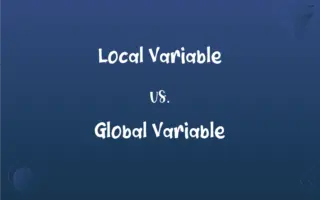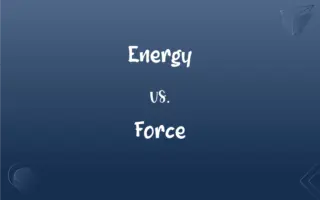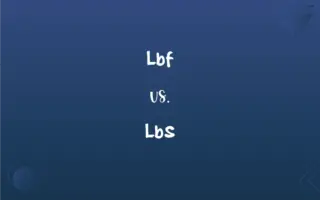Scalar Quantity vs. Vector Quantity: What's the Difference?
Edited by Aimie Carlson || By Harlon Moss || Updated on October 12, 2023
Scalar quantity only has magnitude, like mass or temperature. Vector quantity has both magnitude and direction, like velocity or force.

Key Differences
Scalar quantity is a physical quantity that is entirely described by its magnitude alone. This means that scalar quantity doesn’t take into account the direction. Examples of scalar quantities include distance, speed, mass, and temperature, which are defined by simply quantifying them numerically.
Conversely, vector quantity is a quantity characterized by both magnitude and direction. It cannot be fully described without identifying both these properties. Common examples of vector quantities encompass velocity, force, and acceleration, all of which necessitate both a numerical value and a directional component for comprehensive representation.
Scalar quantity and vector quantity are elemental concepts in physics, providing foundational understanding about the quantities encountered in physical studies. The differentiation between scalar quantity and vector quantity is pivotal for aptly comprehending and depicting physical phenomena.
The identification of scalar and vector quantities is critical in performing mathematical and physical analyses in science. Scalar quantity, with its directionless magnitude, is often easier to manipulate mathematically, as it doesn’t necessitate the use of vector calculus. Conversely, vector quantity, demanding consideration of direction, requires vector algebra or calculus for accurate representation and manipulation in mathematical contexts.
Scalar quantity and vector quantity facilitate apt mathematical modeling and prediction of physical scenarios. Understanding whether a quantity is scalar or vector informs scientists and engineers about the applicable mathematical tools and concepts to utilize, ensuring precise and effective analytical processes in technological and scientific applications.
ADVERTISEMENT
Comparison Chart
Definition
Only has magnitude.
Has both magnitude and direction.
Examples
Speed, Mass, Temperature.
Velocity, Force, Acceleration.
Mathematical Treatment
Handled with standard algebra.
Requires vector algebra or calculus.
Representation
Represented by simple numerical values.
Represented by magnitude and directional arrow.
Physical Implication
Lacks directional impact in phenomena.
Influences phenomena directionally.
ADVERTISEMENT
Scalar Quantity and Vector Quantity Definitions
Scalar Quantity
Scalar quantity can be manipulated using basic algebra.
Adding two temperatures, as scalar quantities, simply involves standard arithmetic addition.
Vector Quantity
Vector quantity requires vector algebra for mathematical manipulations.
Summing two velocities, as vector quantities, necessitates considering both magnitudes and directions.
Scalar Quantity
Scalar quantity remains unaffected by coordinate system rotations.
The distance, a scalar quantity, between two points remains constant regardless of the observer’s position.
Vector Quantity
Vector quantity can be represented graphically with arrows.
Acceleration, a vector quantity, can be illustrated with an arrow pointing in the direction of acceleration and a length representing its magnitude.
Scalar Quantity
Scalar quantity lacks directional attributes.
Mass, a scalar quantity, indicates how much matter an object contains without a directional component.
Vector Quantity
Vector quantity changes upon coordinate system rotation.
Displacement, a vector quantity, may alter its representation with a different observer’s perspective due to its directional attribute.
Scalar Quantity
Scalar quantity does not affect the direction of physical phenomena.
Speed, despite being a scalar quantity, doesn’t provide information on the direction of motion.
Vector Quantity
Vector quantity influences the directionality of phenomena.
Force, a vector quantity, implies both how much and in what direction an object is pushed or pulled.
Scalar Quantity
Scalar quantity is exclusively described by magnitude.
Temperature, being a scalar quantity, is expressed only by degree units without direction.
Vector Quantity
Vector quantity encapsulates both magnitude and direction.
Velocity, a vector quantity, is specified with a speed and a direction, like 60 mph north.
FAQs
How is a vector quantity typically represented graphically?
Vector quantity is often graphically represented with arrows, where length indicates magnitude and arrow direction indicates quantity direction.
Can scalar quantities be negative?
Scalar quantities can be negative depending on the defined measurement scale, such as temperature in degrees Celsius.
Can scalar quantities be added straightforwardly?
Yes, scalar quantities are added, subtracted, multiplied, or divided using basic algebra.
Is the addition of vector quantities simple?
No, adding vector quantities requires considering both magnitudes and directions, often using vector addition rules.
How does scalar quantity impact energy calculations?
Scalar quantity, like energy or work, directly influences calculations without necessitating directionality considerations.
Can scalar quantity be zero?
Yes, scalar quantity can be zero, representing no magnitude, like zero temperature or zero energy.
How is vector quantity instrumental in field theory?
Vector quantity is instrumental in field theory to describe and quantify fields like gravitational and electromagnetic fields which have defined directions at each point in space.
How does scalar quantity influence mathematical equations in physics?
Scalar quantity simplifies mathematical equations in physics as it involves straightforward algebra without considering direction.
How is distance, a scalar quantity, different from displacement, a vector quantity?
Distance only considers magnitude, while displacement involves both magnitude and direction of movement.
What defines a scalar quantity?
A scalar quantity is defined only by its magnitude, lacking directional attributes.
How is a vector quantity characterized?
A vector quantity is characterized by both magnitude and a specific direction.
What role does vector quantity play in physical calculations?
Vector quantity is vital for accurately describing and calculating physical scenarios involving directional movement or force.
Is it essential to consider vector quantity in motion analysis?
Yes, vector quantity is crucial in motion analysis to accurately describe velocity, acceleration, and force, which have directional properties.
Can scalar quantity influence the direction of a physical process?
No, scalar quantity only provides magnitude and doesn’t influence the direction of physical processes.
Is it possible for two vector quantities to result in a scalar?
Yes, through operations like dot product, two vector quantities can produce a scalar quantity.
Why is vector quantity important in electromagnetism?
Vector quantity is pivotal in electromagnetism to describe phenomena like electric fields and magnetic fields which have inherent directions.
Can vector quantity have a negative magnitude?
No, vector quantity cannot have negative magnitude but can point in any direction, which can be considered as positive or negative.
What is a notable example of scalar quantity in physics?
Speed, representing the rate of motion without direction, is a notable example of scalar quantity in physics.
Can a scalar quantity become a vector quantity?
No, scalar quantity inherently lacks direction, while vector quantity requires both magnitude and direction.
Do vector quantities impact physical phenomena directionally?
Yes, vector quantities have a directional impact on the physical phenomena they are associated with.
About Author
Written by
Harlon MossHarlon is a seasoned quality moderator and accomplished content writer for Difference Wiki. An alumnus of the prestigious University of California, he earned his degree in Computer Science. Leveraging his academic background, Harlon brings a meticulous and informed perspective to his work, ensuring content accuracy and excellence.
Edited by
Aimie CarlsonAimie Carlson, holding a master's degree in English literature, is a fervent English language enthusiast. She lends her writing talents to Difference Wiki, a prominent website that specializes in comparisons, offering readers insightful analyses that both captivate and inform.






































































